At FIT, we spend a lot of time pondering the business and the art of dress. But there are so many more stories that clothes can tell. If every dress or pair of pants or skirt could talk, imagine the stories they’d tell. From the depths of December, we offer you some remembrances of summers past, illustrated in clothes and accessories.
This past few years have been tough for the old women in my family. Three women, my grandmother, my great aunt and my ex-mother-in-law, all in their late 90s, finally passed on. So I’ve spent parts of this last couple years sorting through their clothes and pictures and other belongings. And finding out a lot more about these women at their youngest, prettiest and most fashionable. What do these things express about these women? Hope? A sense of their own desirability? Social status? Pleasure? Love? Financial independence? The kinds of activities they enjoyed?
My Great Aunt Emilie (second from the left in the pic above) was first generation American, born to a father and mother (fourth and fifth from the left in the pic above) who’d moved from Poland in about 1909. Never married, she lived in the same home in Philadelphia for 56 years. When we cleaned it out (a very sad task), we found many many shoes, golf clothes (she was an avid golfer well into her 80s), Christmas cards from 30 years, slips, gloves and beautiful, splendid hats! And many many boxes of good jewelry, including dinner rings, dressy pins, and strings of pearls. To me these tell a story of a stubborn woman who lived an unconventional life (she never married) who took good care of herself (she golfed weekly, owned her own home, and left comfortable allowances to charities in her will), but allowed herself many pleasures due to her financial independence.
These hats were all still carefully wrapped in tissue, and kept in their Bergdorf Goodman boxes:
I was surprised how much our assumptions about the necessities of dress have changed. When was the last time you wore a hat to any occasion? She had all kinds: these two spring floral confections were popular in the early 60s.
This lovely black beaded number was custom made by a Philadelphia milliner, and closely resembles one from a late-50s Dior photograph.
This plasticized-straw boater has a tall enough crown that it looks later 60s. With a patent-leather band, it is perfect for summer outings at the golf club, where Emilie was the center of a lively circle of friends.
Have you ever worn a slip? Or gloves? Aunt Emilie had many of all of these, never thrown away. The white gloves are very proper, but each has an embroidered or cutwork detail. The two outside pairs are knit, but the center glove is fine kid leather. And howabout the sauciness of the yellow pair?
I especially love that she had this hot pink lacy slip. I doubt anyone else ever saw it, but that’s the point, isn’t it. My very proper maiden great aunt wore these pretty things to please herself.
In a letter we found, toasting her at her retirement dinner, both her determination, her signature items of jewelry, and her fondness for travel were each mentioned gleefully.
Last June I spent time going through the wardrobe of my former mother-in-law, Rena Mae. Daughter of an Arkansas circuit minister, she married a dashing Army pilot who was stationed in her town during World War II. Richard brought her back to his hometown of New York, and they lived comfortably in a large home in Melba, Queens. They had two children. Rena Mae was a school teacher for many years, but she also had the luxury of funds offered by a husband with some financial skills. Amongst the many ladylike daywear pieces were a few delicate evening and cocktail dresses from days gone by. She also had dresses from nearly every decade in summery ginghams and eyelets.
And these:
Rena Mae also had a few skirts similar to this Vogue Pattern from 1975 (we have the Pattern Catalogs at the PERS desk). She may even have made one from this pattern or one like it. Every woman I knew in the 1970s sewed, and my mother made most of their own clothes and a lot of mine and my brother’s. I know my mom made a skirt like this. I wore it when I was in high school.
Looking through these clothes brought back memories of summer vacations when I was a kid.
My grandmother Georgia was also a southern lady. She grew up in the old south, on a large cotton farm in Wisner, Lousiana. She remembered traveling by horse-and-buggies. Once she graduated from the University of New Mexico, she and a friend moved to Chicago on a lark. There she taught public school and eventually married my grandfather, Dan, a handsome, witty Irish-American who worked for the water department. Together they raised two families: they had two sons, Danny and Neil. She also inherited Dan’s part-time family from his first marriage, my father and my aunt, handling the brood with grace and patience at a time when divorce was still scandalous. They traveled cross country several times a year in order to keep in touch with family members in California, Florida, Louisiana, Ohio, and Montana. She embroidered and quilted, giving each grandchild a quilt she’d made. As email became popular, she became an avid user in order to stay close to her far-flung family. She was 99.
Clothing seems to be firmly attached to the idea of memories, especially for women. The library has a number of books that use clothing as a framework for memoirs.
A Lady of Fashion: Barbara Johnson’s album of styles and fabrics, edited by Naomi Tarrant. 5th Floor Main GT736 .L25.
Fabric of society : a century of people and their clothes, 1770-1870 : essays inspired by the collections at Platt Hall, the Gallery of English Costume, Manchester, by Jane Tozer and Sarah Levitt. 5th Floor Main GT736 .T69
Shocked: My Mother, Schiapiarelli, and Me, by Patricia Volk. 5th Floor Main TT505 .S3 V65
Beaton: The Art of the Scrapbook, by Cecil Beaton, introduced by James Danziger. 5th Floor Main, TR 140 .B4 A255
Love, Loss and What I Wore, by Ilene Beckerman. 5th Floor Main GT617.N4 B43 1995
Pretty in Plaid: A Life, a Witch and a Wardrobe, by Jen Lancaster. 5th Floor Main PS3612 .A54748
In loving memory of
Emily M. Osinski 1913-2011,
Rena Mae Krevor 1917-2011, &
Georgia Knotts McMahon 1913-2013
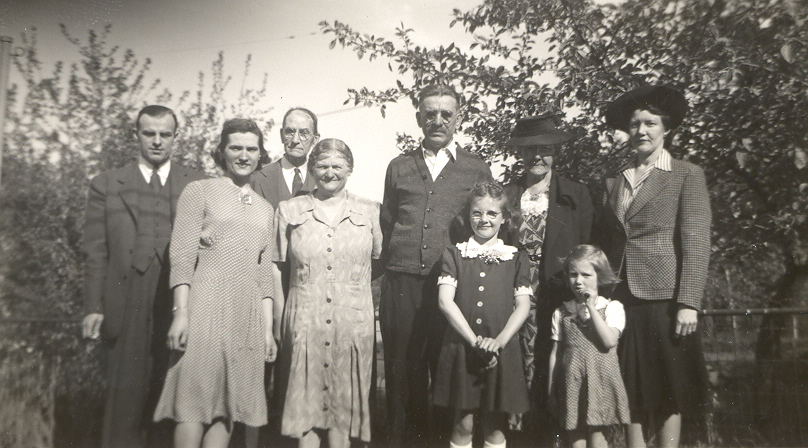
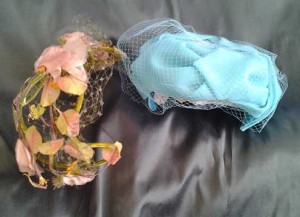
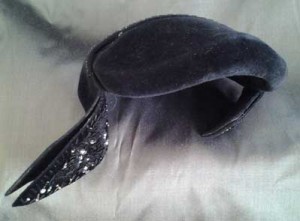
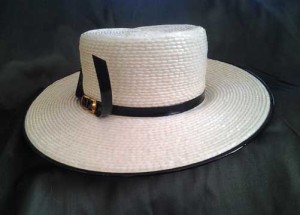
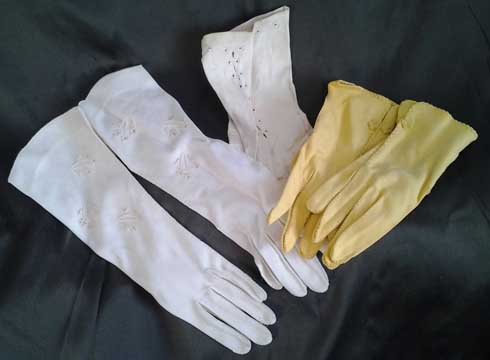
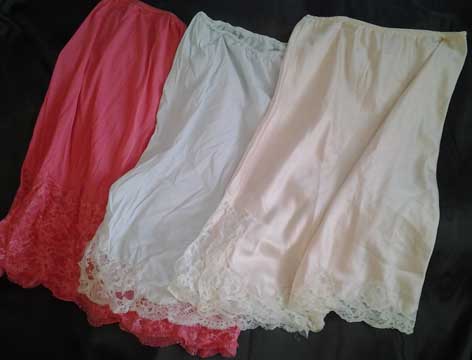
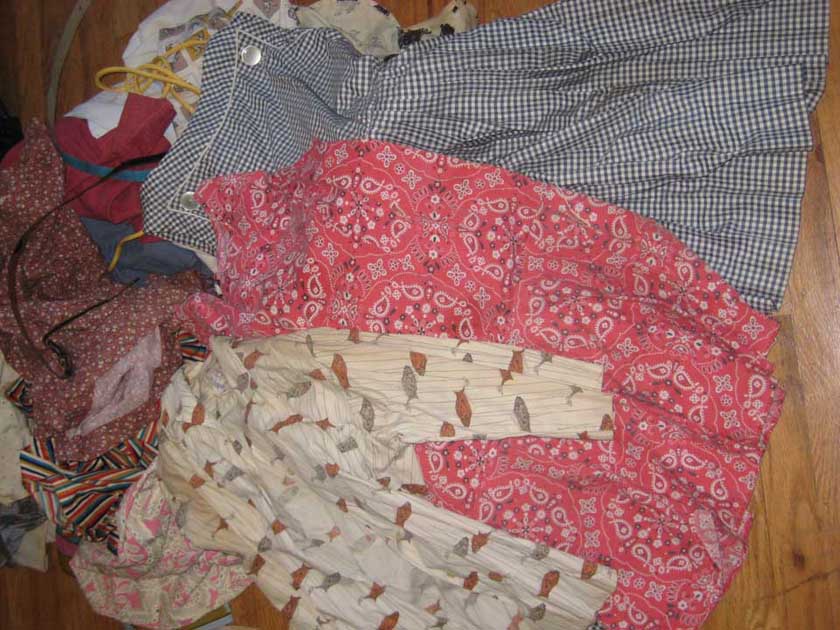

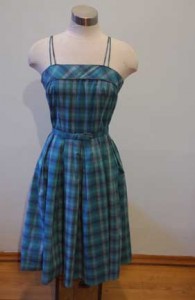

Comments
5 responses to “Love, Loss, & Auld Lang Syne”
Lovely post!
[…] http://blog.fitnyc.edu/volumesandissues/2013/12/30/love-loss-auld-lang-syne/ […]
Hi
Those 3 half slips are to die for, I would have gladly bought them from you. I still wear half slips under my unlined skirts & dresses, but cannot find the glamorous ones of the 1960s
Since my last comment back in August, I was still wishing to find out if you might consider selling those 3 awesome half slips that belonged to your grandmother? I can assure you that they would be going to a very good home. I wear skirts & dresses a lot and as many are unlined I like to wear a slip which I find increasingly difficult to find in the stores. When I do find them, they are usually made of modern fabrics like polyester which is nothing like the nylon ones they manufactured in the 1950’s & 1960’s which I remember only too well. Best wishes, Patsy
You know, I think that would be fine. Email me “off” the work page at [email protected]. And Happy New Year!